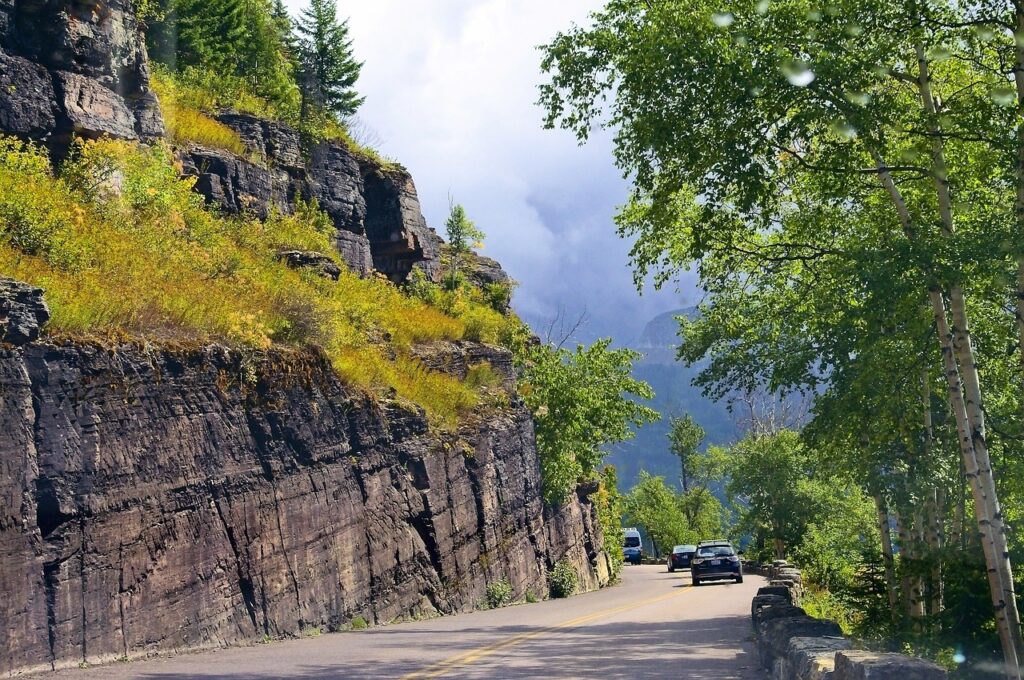Going-to-the-Sun Road: Montana’s Mountain Majesty Unfolded
Winding its way through the heart of Glacier National Park, the Going-to-the-Sun Road is more than just a scenic drive — it’s a journey through time, geology, and wilderness. It ranks among the most spectacular in North America. Carved into the mountainsides of northwestern Montana, this 50-mile engineering marvel offers access to the park’s most iconic views, crystal lakes, alpine meadows, and towering peaks. To drive it is to witness nature at its most sublime — and to feel humbled by the mighty American Rockies.
Whether you’re behind the wheel, riding a red “jammer” bus, or pedaling a bicycle before dawn, the Going-to-the-Sun Road is not merely a way to get somewhere — it is the destination.

An Engineering Wonder in the Wild
Completed in 1933, after more than two decades of planning and construction, Going-to-the-Sun Road was a groundbreaking feat for its time. It was the first road in the United States designed specifically for scenic tourism, intended not to tame the wilderness, but to reveal it. Designed to blend with the landscape, it hugs cliffs, crosses roaring waterfalls, curves around glacial valleys and offers jaw-dropping views that make passengers reach for their cameras every few hundred feet.
Named after Going-to-the-Sun Mountain, a striking peak in the park’s eastern section, the road spans from West Glacier to St. Mary. It slices through the Continental Divide at Logan Pass (6,646 feet). Along the way, travelers encounter all the major ecosystems of Glacier National Park, from cedar-filled valleys to windswept tundra.
Click here for a Private Full Day Luxury Tour at Yellowstone Park.
The Drive of a Lifetime
Driving Going-to-the-Sun Road is a rite of passage for nature lovers, road trippers, and adventure seekers alike. The best time to experience the road is late June to early October. That is when snow removal — a monumental task that can take up to 10 weeks — is complete and the full route is open.
Beginning in West Glacier, the road quickly enters dense forest along the shores of Lake McDonald, the park’s largest lake. Towering lodgepole pines line the water, and reflections of the surrounding peaks shimmer in the surface. Just beyond, the road begins its dramatic climb.
Drivers ascend through The Loop, a tight switchback offering the first panoramic glimpses of the Livingston Range. Waterfalls spill from cliffs above. Deer and black bears are often seen near the roadside. Then comes the heart of the experience: the high alpine section leading to Logan Pass.
Here, the road clings to the cliffs with sheer drop-offs on one side and jagged rock walls on the other. The Weeping Wall drips with snowmelt, and every curve opens to a new, breathtaking view — of emerald valleys, glacier-carved peaks, and endless sky.
At Logan Pass, travelers find a visitor center and access to one of the park’s most beloved hikes: the Hidden Lake Trail, which offers close-up views of wildflowers, mountain goats, and (occasionally) grizzly bears.
From there, the descent toward St. Mary Lake offers a different, but equally mesmerizing experience — wide views of the east side’s more rugged, windswept beauty, with craggy ridgelines, golden grass, and long, glowing sunsets.
Click here for the Couples Do It All Yellowstone 4 day/3 nights All 5 Entrances Tour.
Not Just a Drive — A Journey Into Nature
The beauty of Going-to-the-Sun Road isn’t confined to your car window. The route is lined with overlooks, trailheads, and scenic pullouts, each one worth a stop. Some favorites include:
- Trail of the Cedars – a short, accessible loop through an ancient forest of towering red cedars.
- Avalanche Lake Trail – a moderate hike ending at a turquoise lake surrounded by waterfalls.
- Jackson Glacier Overlook – one of the best places to view a glacier from the road.
- Sunrift Gorge and Sun Point – easy trails with rewarding views and a chance to explore the shoreline of St. Mary Lake.
Wildlife is abundant throughout the route. Keep an eye out for bighorn sheep, marmots, mountain goats, and even the occasional grizzly bear — particularly in the alpine meadows around Logan Pass. Birdwatchers may spot golden eagles or peregrine falcons soaring above the peaks.
Click here for the The Grand 3 Days of Private Yellowstone Tours West Yellowstone.
Photography Paradise
Going-to-the-Sun Road is a dream for photographers. Whether capturing the pink alpenglow on the mountains at dawn, reflections on Lake McDonald, or dramatic cloudscapes over Logan Pass, this road provides endless opportunities for visual storytelling. Early morning and late afternoon offer the best light, and weather changes can produce everything from misty mystery to crystal-clear grandeur.
For truly unforgettable images, consider venturing out for sunrise at Wild Goose Island Overlook — one of the most photographed spots in the entire national park system. The tiny island sits in the middle of St. Mary Lake, framed by dramatic peaks and often lit by golden first light.
Click here for a 5-day In-Depth Yellowstone and Grand Teton National Park Tour.
Preserving a Legacy
Maintaining Going-to-the-Sun Road is no small task. Each winter, avalanches and heavy snowfall damage sections of the roadway. The narrow, historic design presents modern engineering challenges. But preservation efforts have been meticulous, ensuring the road retains its original character while improving safety and durability.
To manage crowding and protect the fragile ecosystems nearby, the National Park Service has instituted a reservation system during peak months. It requires advance vehicle passes for daytime access. This helps preserve the serenity of the drive. It also encourages visitors to explore the park more deeply, whether by shuttle, foot, or bicycle.

Click here for a fantastic collection of stylish and practical menswear.
Planning Your Visit
- When to go: Late June to early October is the best time, when the full road is typically open. July and August are peak months.
- Reservations: Vehicle reservations are required to drive the road in summer.
- Shuttles: Free park shuttles operate along parts of the road — a great option for those without a reservation.
- Lodging: Stay in nearby towns like Whitefish, Columbia Falls, or within the park at historic lodges like Lake McDonald Lodge or Many Glacier Hotel.
- Weather: Be prepared for rapid changes. Even in summer, temperatures can vary drastically between elevations.
Click here to learn about the home of American heroism.
A Drive That Stays With You
Going-to-the-Sun Road is more than a way to see Glacier National Park — it is Glacier National Park. Every curve of its route, every vista it reveals, speaks to the majesty of the northern Rockies. It was the vision of those who built the road to share that beauty with the world.
It’s a drive that demands attention — not just to the road itself, but to the scenery, the silence, and the deep sense of awe it inspires. Whether you’re visiting for the first time or returning for the tenth, Going-to-the-Sun Road will leave you with a sense of wonder that lingers long after the last mountain disappears in your rearview mirror.

